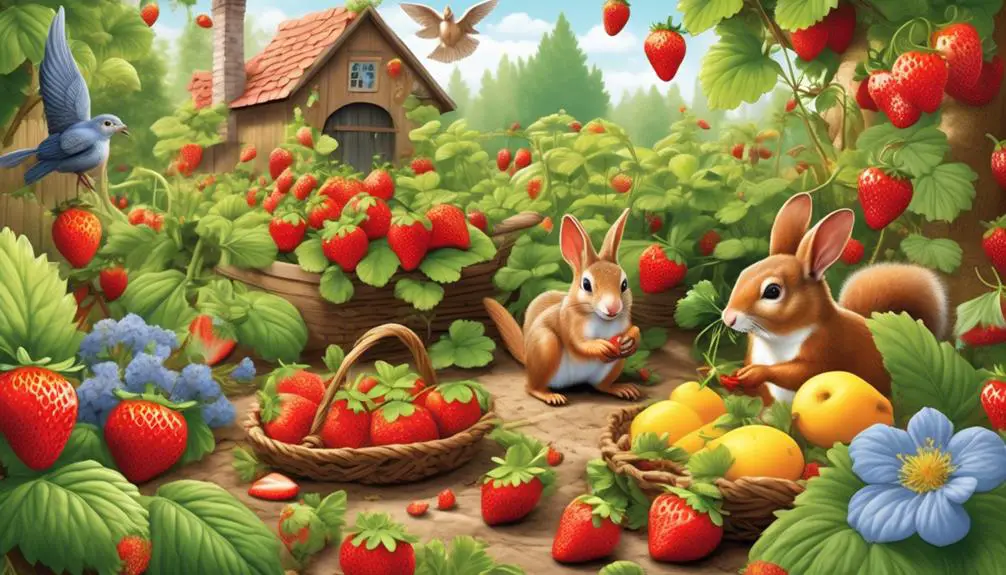Are you tired of discovering your luscious strawberries devoured by uninvited guests? It’s frustrating to witness these delectable fruits being devoured by creatures who can’t resist their sweet allure.
From nimble squirrels to mischievous raccoons, there seems to be a never-ending parade of animals that have developed a taste for your garden’s strawberries. But fear not, for there are effective techniques to protect your precious crops.
In this article, we will unravel the mystery of these strawberry-loving animals and equip you with the knowledge to defend your garden against their insatiable appetites.
So, let’s uncover the secrets and reclaim your strawberry harvest.
Squirrels
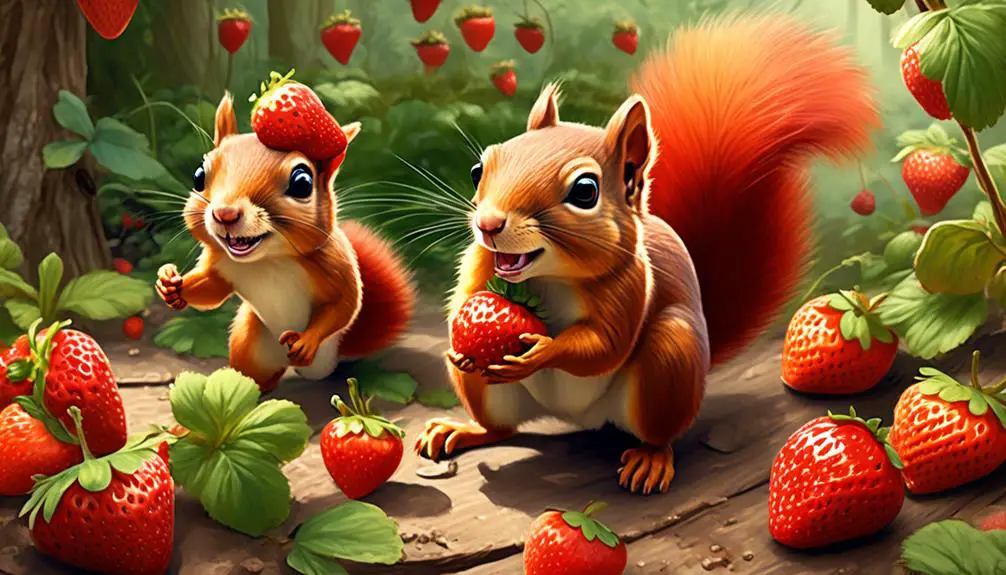
Do squirrels have a preference for strawberries due to their high sugar levels and juicy texture?
Squirrels, highly energetic creatures, are known to eat various fruits, including strawberries. They’re attracted to strawberries because of their high sugar levels and juicy texture. These small mammals can easily find gardens and backyards as a food source, where they specifically target soft and sweet fruits like strawberries. As strawberries ripen, they become more juicy, making them even more attractive to squirrels.
Squirrels are opportunistic feeders and will consume anything edible. However, they show a particular fondness for strawberries due to their sweetness and succulent texture. The high sugar content in strawberries provides a quick source of energy for these active animals. Squirrels can quickly detect ripe strawberries by their vibrant red color and strong aroma. Once they locate a ripe berry, they’ll eagerly bite into it, savoring the explosion of flavors.
To protect strawberry plants from squirrels, gardeners can implement various methods. Creating physical barriers using wire mesh or netting can effectively deter squirrels from accessing the plants. Additionally, using repellent sprays specifically designed for squirrels can discourage them from approaching the strawberry plants. By employing these preventive measures, gardeners can minimize the damage caused by squirrels and ensure a bountiful harvest of strawberries.
Raccoons
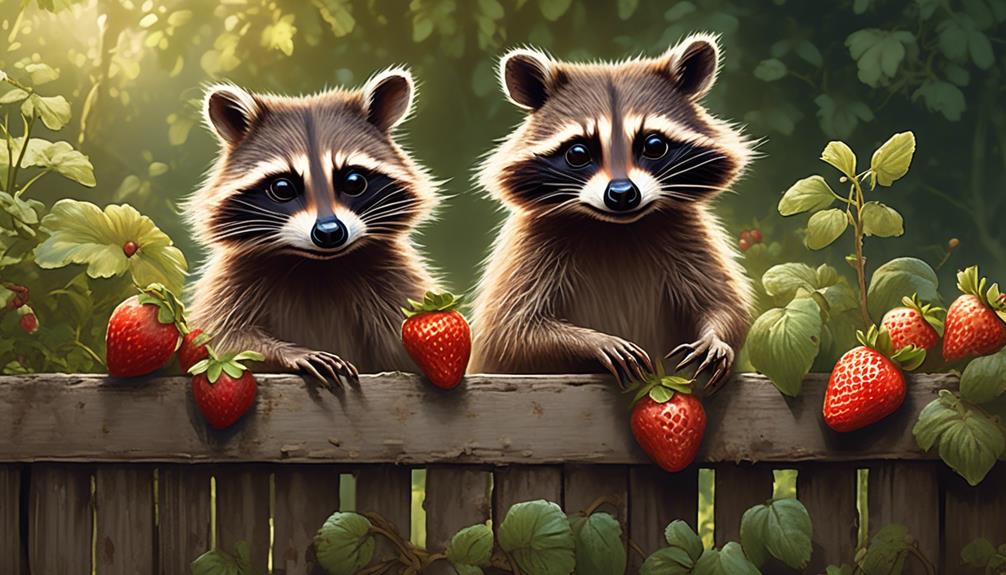
Raccoons, being omnivores and known for their ability to damage sweet corn crops, have a wide-ranging diet that includes strawberries, melons, potatoes, peas, and tree fruits. These clever creatures are attracted to the sweetness and juiciness of strawberries, making them a target in your garden. Raccoons are known to cause significant damage to strawberry plants as they feed on the ripe fruits.
To protect your strawberries from raccoons, there are several effective methods you can employ. Repellent sprays can be used to deter raccoons from approaching your crops. Additionally, wildlife nets can be installed to create a physical barrier, preventing raccoons from gaining access to the plants. Another method is to place plant pots upside down and cover them with netting, effectively protecting the strawberries.
It is important to note that raccoons are persistent and resourceful animals, so it may be necessary to employ multiple deterrents simultaneously. Regularly inspect your garden for signs of raccoon activity and adjust your protective measures accordingly.
Chipmunks
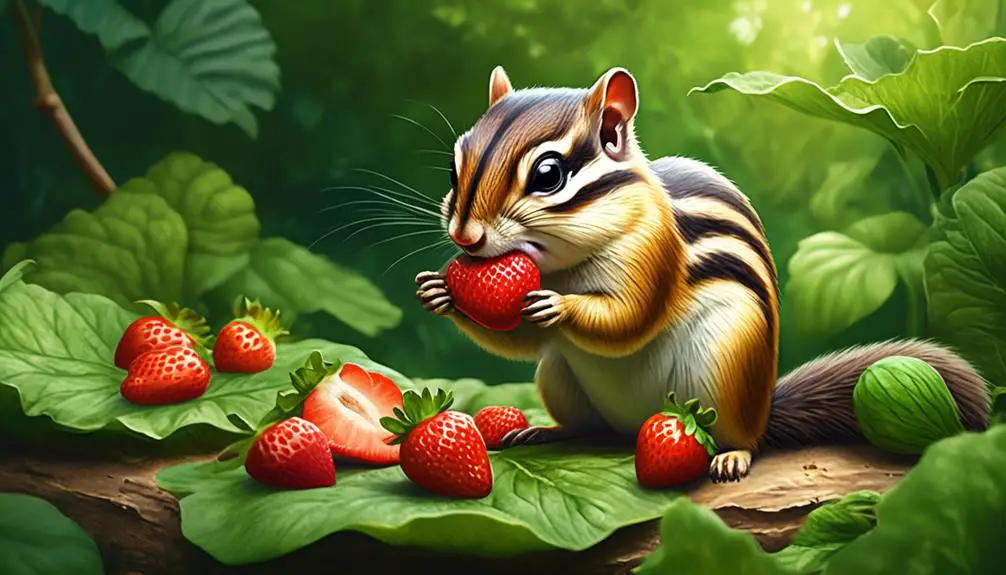
After discussing the strategies to protect strawberries from raccoons, let’s now shift our focus to chipmunks and their feeding habits.
Chipmunks are opportunistic feeders and will eat anything edible. They’re active during the day and prefer not to forage at night. While chipmunks may take a quick bite of juicy strawberries, they don’t typically cause significant damage to crops.
Strawberries become juicy as they ripen, making them attractive to chipmunks. However, chipmunks tend to only consume a small portion of the fruit before moving on to other food sources.
To protect strawberries from chipmunks, consider using physical barriers such as wire mesh or netting. These barriers can be placed over plants or entire garden beds to prevent chipmunks from accessing the fruit.
It’s also important to keep the garden area clean and free of fallen fruit, as this can attract chipmunks and other animals.
Birds
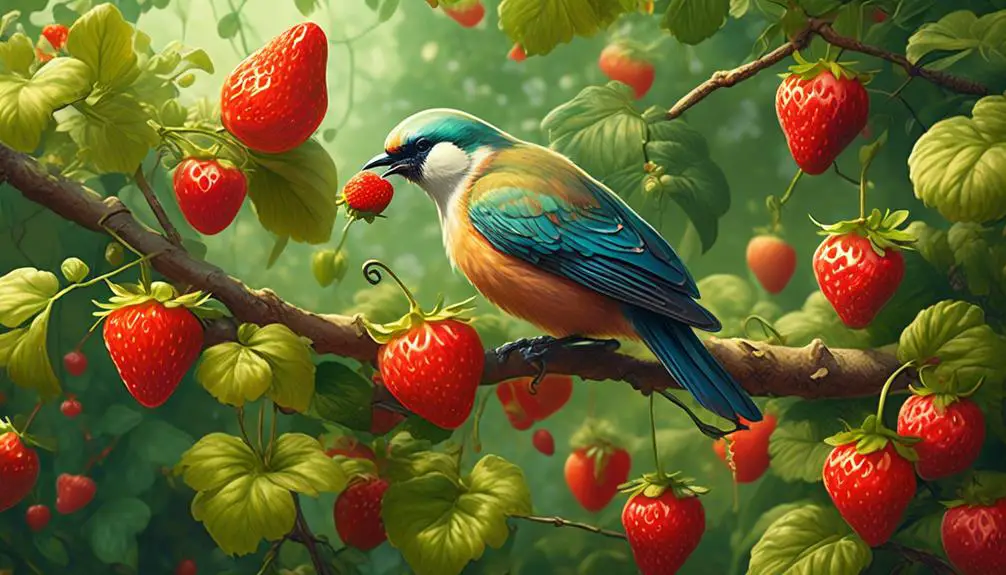
Birds are a common group of animals that enjoy eating strawberries. Many bird species, such as crows, robins, and blue jays, are known to feast on these delicious fruits. Birds are attracted to strawberries because of their bright color, sweet aroma, and high sugar content. They’ve a keen sense of sight and can easily spot ripe strawberries from a distance.
To protect your strawberry plants from bird damage, there are several effective methods you can employ. Hanging metallic tapes or tins near the plants can create reflective surfaces that deter birds. Bird netting can also be used to cover the plants, preventing birds from accessing the fruits. Barrier or exclusion methods, such as using chicken wire or custom-made frames, can be effective in keeping birds away from the plants.
It is important to remember to remove the barriers during the harvesting season to allow easy access to the strawberries. Additionally, keeping the garden well-maintained and free of fallen fruits can help reduce bird attraction to the area.
Insects
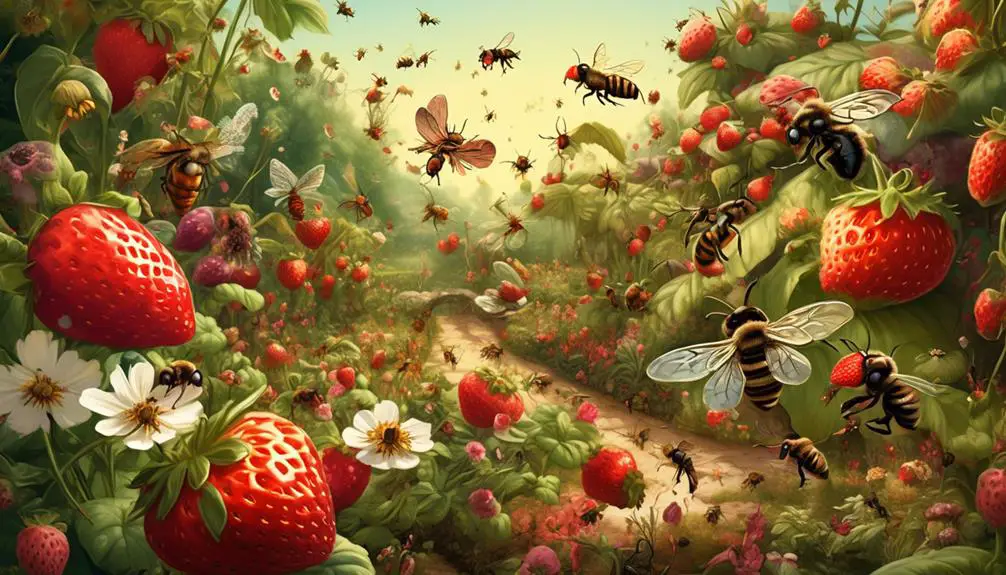
Insects play a significant role in the consumption of strawberries, as they are attracted to the sweet aroma and high sugar content of these fruits. They can cause damage to the plants by feeding on the leaves, stems, and fruits. Some common insects that eat strawberries include aphids, thrips, strawberry weevils, and strawberry crown moth larvae.
| Insect | Damage caused |
|---|---|
| Aphids | Suck the sap from the leaves, causing them to wilt and distort. They also excrete honeydew, attracting ants. |
| Thrips | Feed on the flowers and fruits, causing scarring and deformities. |
| Strawberry Weevils | Adult weevils feed on the leaves, while the larvae bore into the fruit, leaving behind tunnels and rot. |
| Strawberry Crown Moth Larvae | Larvae feed on the crown, causing wilting, stunting, and reduced fruit production. |
To protect your strawberry plants from these insects, it is important to regularly inspect the plants for signs of infestation and take appropriate measures. This can include the use of insecticides, biological control methods such as introducing beneficial insects, or physical barriers like netting or row covers. Additionally, practicing good garden hygiene by removing fallen leaves and fruits can help reduce the presence of insects and prevent the spread of diseases. By actively monitoring and managing insect populations, you can minimize the damage caused by insects and ensure a healthy crop of strawberries.
Deer
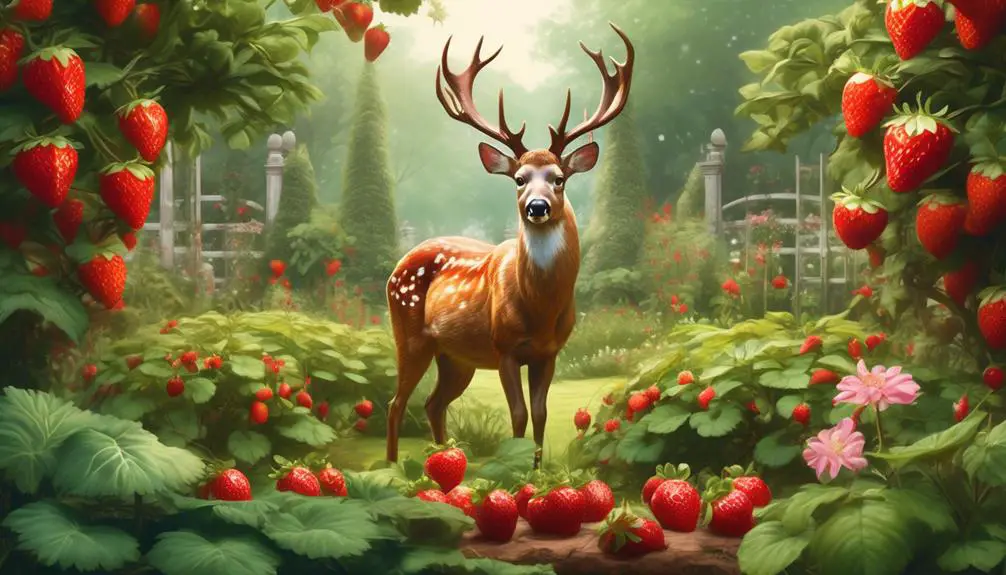
Deer are known to have a preference for strawberries, making them one of the primary animals that consume these fruits. Although the primary diet of deer consists of leaves and various plant parts, strawberries are among the most sought-after fruits for them. These majestic creatures may venture into your garden in search of these sweet and juicy treats.
To protect your berry plants from deer, it’s recommended to use mesh hardware cloth and build a strong and protective cylinder around the plant. This will create a physical barrier that deters deer from accessing the strawberries. It’s important to ensure that the mesh is securely attached to the ground to prevent deer from sneaking underneath.
Furthermore, maintaining a clean and well-maintained garden can also help discourage deer from entering. Removing fallen fruits and debris can eliminate attractants that may entice deer to your garden.
Deer can be persistent and resourceful when it comes to finding food, so it’s crucial to be proactive in protecting your strawberry plants. By implementing these measures, you can enjoy the fruits of your labor while keeping these graceful creatures at bay.
Rabbits
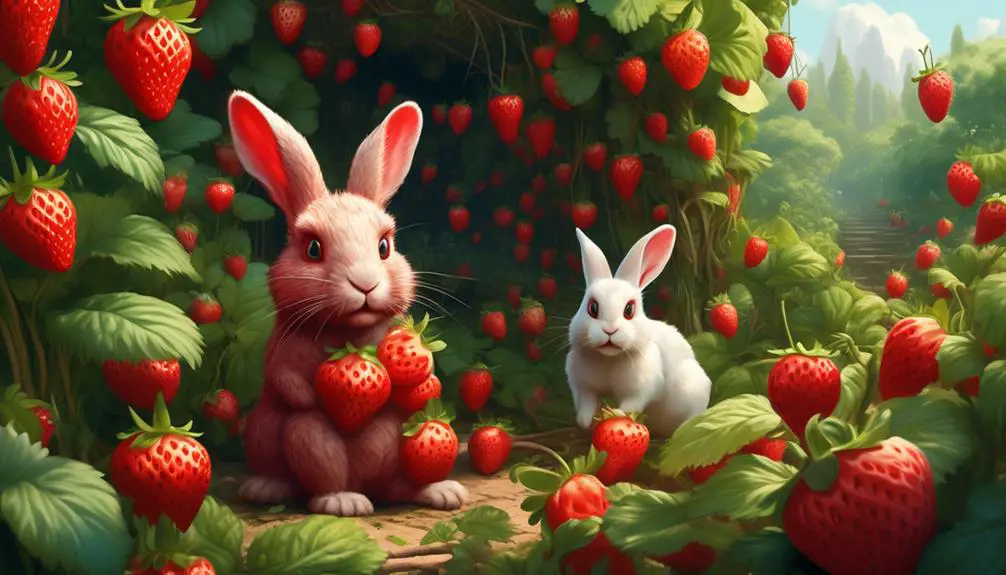
Rabbits, clever creatures with a sweet tooth for red berries, including small strawberries, can also feed on foliage and other tender parts of the plant.
These herbivorous animals have sharp incisors that allow them to easily munch on the leaves and stems of strawberry plants. They’re known to be opportunistic feeders and won’t hesitate to take a bite out of juicy strawberries as well.
Rabbits are attracted to the sweetness of strawberries, which is due to their high sugar content. As they ripen, strawberries become even juicier, making them even more enticing to rabbits.
It’s important to note that rabbits may not only target the fruits but also the foliage, stems, and other tender parts of the plant.
To protect your strawberry plants from rabbit damage, you can consider using physical barriers such as wire mesh fences or chicken wire cages. These barriers should be tall enough and securely installed to prevent rabbits from accessing the plants.
Additionally, regular inspection of the plants and prompt removal of any rabbit droppings or signs of feeding can also help deter these clever creatures from continuously targeting your strawberry plants.
Marmots
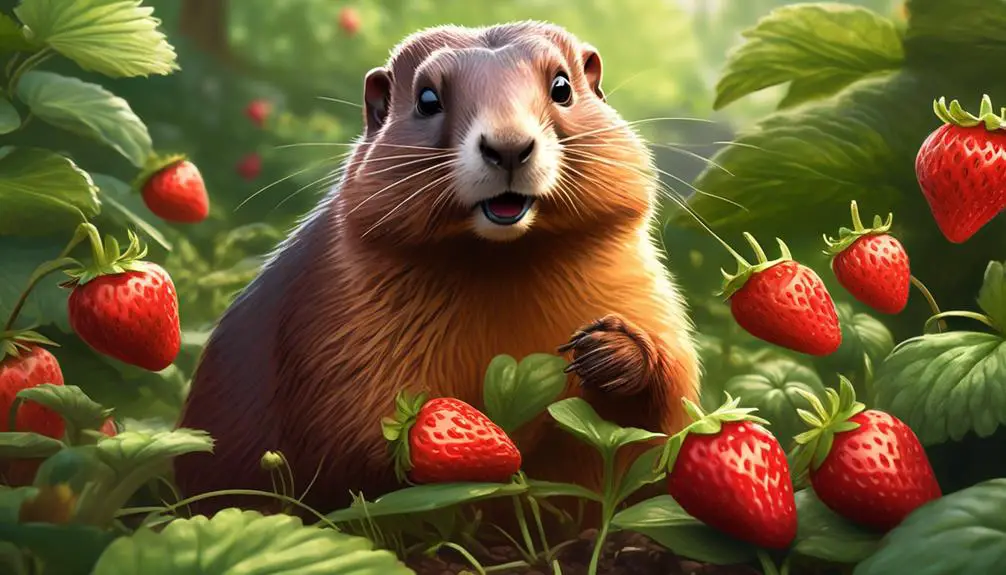
Marmots, known for their love of the taste of strawberries and their potential to damage the crop, are a species of animal that should be considered when protecting strawberry plants. These large ground-dwelling rodents are often found in mountainous regions and can be a nuisance to gardeners who cultivate strawberries. To better understand the behavior and impact of marmots on strawberry plants, let’s examine their characteristics and recommended protective measures.
| Marmots | Protective Measures |
|---|---|
| – Omnivores | – Build a wooden cage with wire mesh to protect plants |
| – Prefer high-altitude habitats | – Fencing may not always keep rabbits and rodents away |
| – Hibernate during winter | – Utilize repellent sprays if necessary |
| – Excellent climbers | – Remove debris and potential hiding spots near plants |
| – Active during the day | – Use motion-activated sprinklers to deter marmots |
Marmots are opportunistic feeders and will not hesitate to consume ripe strawberries when given the chance. Their ability to climb and burrow makes them particularly adept at accessing strawberry plants. To protect strawberry crops from marmots, it is recommended to construct a sturdy wooden cage with wire mesh that encloses the plants. This physical barrier will prevent marmots from reaching the strawberries while still allowing sunlight and rain to reach the plants.
It’s important to note that traditional fencing may not always be effective in deterring marmots, as they are skilled climbers. Additionally, utilizing repellent sprays and removing debris around the plants can further discourage marmots from approaching the strawberry crop. Motion-activated sprinklers can also be employed to startle and deter these rodents from damaging the plants.
Tortoises and Turtles
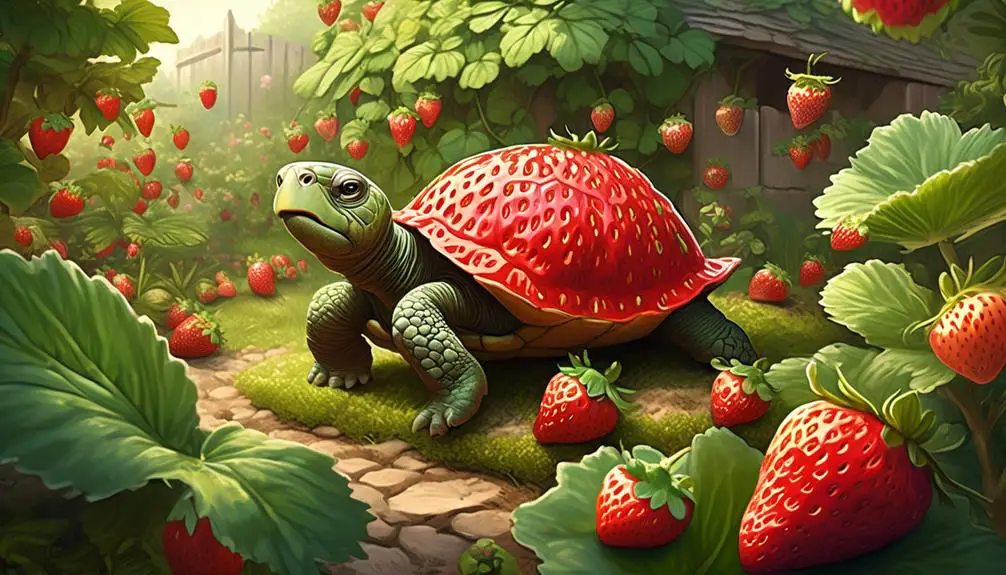
Tortoises and turtles, being shelled creatures that can occasionally indulge in strawberries and other tropical fruits, should be considered when determining their dietary needs and potential risks associated with consuming high-sugar foods.
While these reptiles primarily feed on vegetation, they may occasionally be tempted by the sweet taste and juicy texture of strawberries. However, it’s important to note that the high sugar content in strawberries can be harmful to shelled creatures. Therefore, it’s recommended to offer strawberries as an occasional treat rather than a regular part of their diet.
It’s also crucial to ensure that the strawberries provided are fresh and free from any pesticides or harmful substances. Additionally, it’s important to consider the overall nutritional balance of their diet, which should consist mainly of leafy greens, vegetables, and other appropriate foods. Providing a varied and well-rounded diet is essential for the health and well-being of tortoises and turtles.
Always consult with a veterinarian or reptile specialist for specific dietary recommendations based on the species and individual needs of your tortoise or turtle.
Hamsters
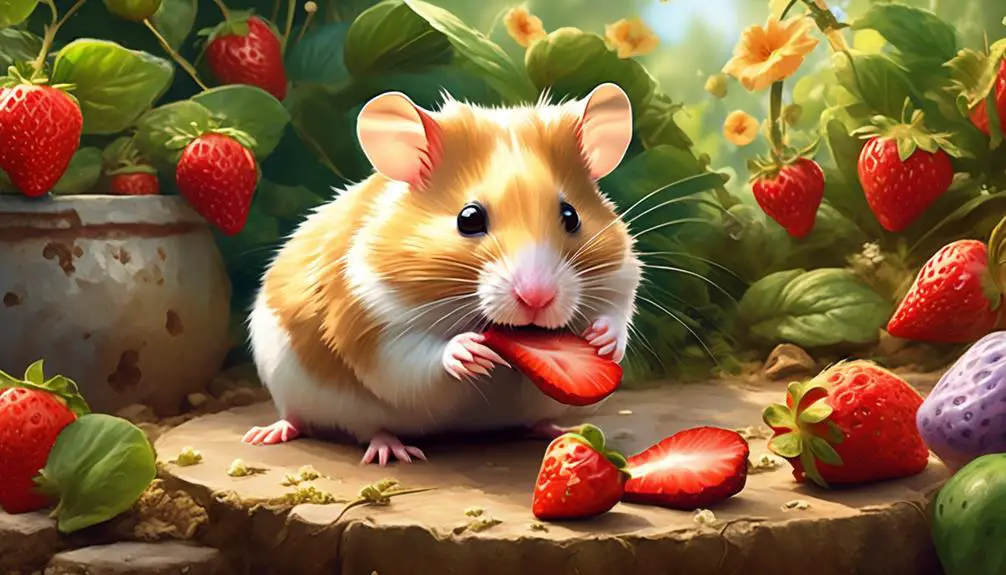
Hamsters can safely consume small amounts of strawberries without harm, making them a tasty and occasional treat for these small rodents. Strawberries provide hamsters with a variety of nutrients, including vitamins C and K, fiber, and antioxidants.
However, it’s important to feed hamsters strawberries in moderation, as large amounts can lead to digestive issues. Offering a teaspoon of tiny slices of strawberry once or twice a week is sufficient.
When feeding strawberries to hamsters, it’s crucial to remove any leftover fruit from the pen or cage to prevent mold growth. Additionally, it’s recommended to wash the strawberries thoroughly before serving them to hamsters to remove any pesticides or harmful residues.
While hamsters enjoy the juicy and sweet taste of strawberries, it’s important to remember that strawberries should only be given as a treat and shouldn’t replace their regular diet of hamster pellets and fresh vegetables.
Cats
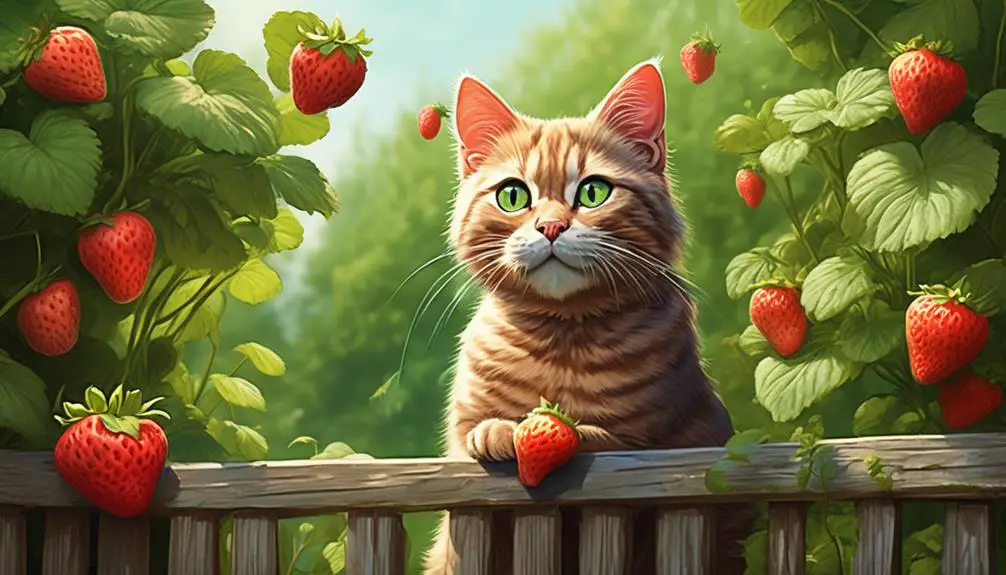
Do cats eat strawberries, and are they safe for them to consume?
Cats are obligate carnivores, which means their diet primarily consists of meat. While cats don’t naturally seek out fruits, some may show interest in strawberries. However, it’s important to exercise caution when offering strawberries to cats.
Strawberries aren’t harmful to cats in small quantities, but they shouldn’t be a significant part of their diet. Cats lack the enzymes necessary to break down plant material effectively, including the sugars found in strawberries. Consuming large amounts of strawberries may lead to digestive upset, such as diarrhea or vomiting.
Additionally, strawberries should be given to cats without any added sugars or sweeteners, as these can be toxic to them. If you choose to give strawberries to your cat, ensure they’re thoroughly washed and cut into small, bite-sized pieces to prevent choking hazards.
As always, it’s best to consult with your veterinarian before introducing any new food into your cat’s diet.
Dogs
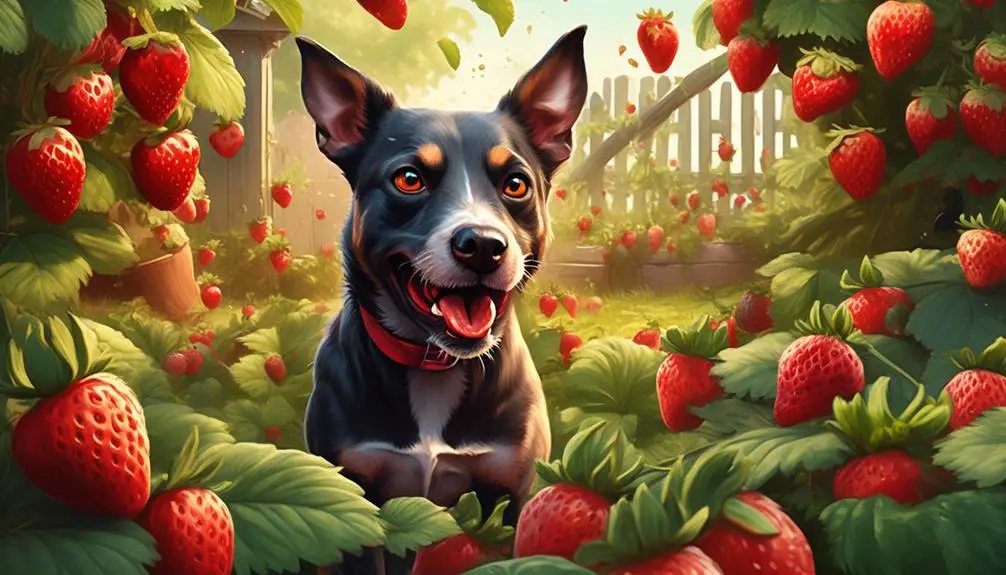
Dogs can eat strawberries in moderation, but there are potential risks to consider. While strawberries aren’t toxic to dogs, they should be given in small amounts as a treat due to their high sugar content.
Feeding large amounts of strawberries to dogs can lead to digestive issues, such as diarrhea and upset stomach.
Can Dogs Eat Strawberries?
Strawberries may be a delicious treat for many animals, but when it comes to dogs, it’s important to consider their dietary needs and potential risks before offering them this fruity delight.
While dogs can eat strawberries, it’s crucial to feed them in moderation. Strawberries are low in calories and provide essential vitamins, minerals, and antioxidants that support overall health. However, the high sugar content in strawberries can be harmful to dogs if consumed in large quantities.
Additionally, some dogs may have allergies or sensitivities to strawberries, resulting in digestive issues like diarrhea or upset stomach. It’s recommended to introduce strawberries gradually into a dog’s diet and monitor their reaction.
It’s also important to remove the strawberry stems and leaves, as they can pose a choking hazard. Consult with a veterinarian before adding strawberries to your dog’s diet to ensure it aligns with their specific nutritional needs.
Potential Risks for Dogs
Before incorporating strawberries into your dog’s diet, it is important to be aware of the potential risks they may pose. While strawberries can be a tasty and nutritious treat for humans, they may not be suitable for dogs due to several reasons. First, strawberries contain natural sugars that can lead to weight gain and dental issues in dogs if consumed in large quantities. Additionally, some dogs may be allergic to strawberries, which can cause digestive problems such as diarrhea or vomiting. Moreover, the seeds of strawberries can pose a choking hazard or cause intestinal blockage if ingested by dogs. It is always best to consult with a veterinarian before introducing strawberries or any new food into your dog’s diet to ensure their safety and well-being.
| Potential Risks for Dogs |
|---|
| Weight gain and dental issues |
| Allergic reactions and digestive problems |
| Choking hazard and intestinal blockage |
Other Garden Pests
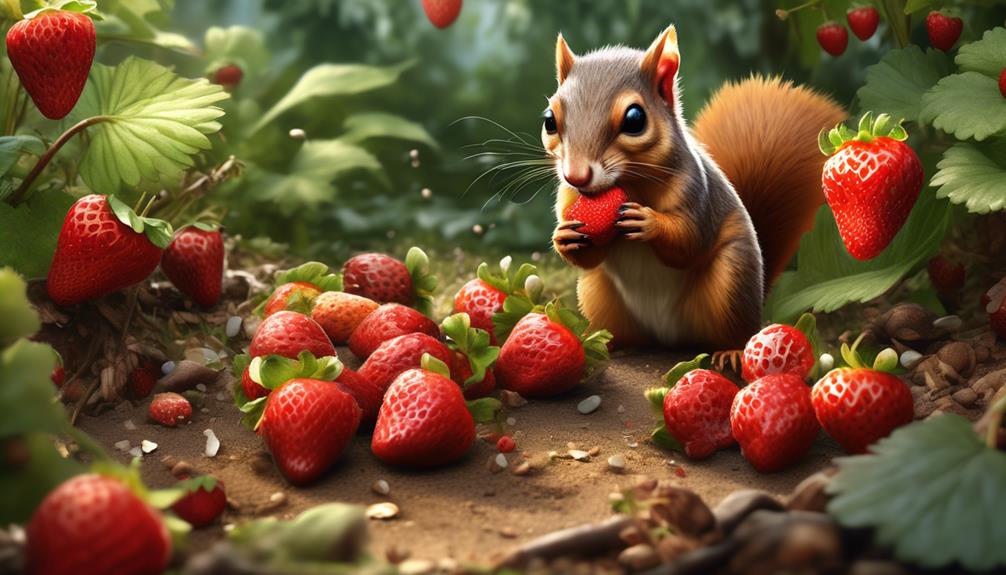
Various pests can pose a threat to your garden, causing damage to plants and crops. In addition to the animals mentioned previously, there are other garden pests that you need to be aware of.
One common garden pest is the aphid. These small insects have soft bodies and feed on the sap of plants, including strawberries. They can multiply rapidly, causing stunted growth and deformed leaves. To control aphids, you can use insecticidal soap or introduce natural predators like ladybugs.
Another garden pest to watch out for is the cutworm. These caterpillars are nocturnal and feed on the stems of young plants, including strawberry plants. They can cut through the stems at ground level, causing the plants to wilt and die. To protect your plants from cutworms, you can use collars made of cardboard or plastic around the base of the plants.
Slugs and snails are also common pests in the garden. These slimy creatures feed on the leaves and fruits of strawberries, leaving behind holes and trails of slime. To control slugs and snails, you can use traps, barriers, or organic slug pellets.
Lastly, fungal diseases such as gray mold (Botrytis cinerea) and powdery mildew (Erysiphe spp.) can affect strawberry plants. These diseases can cause rotting of fruits, wilting of leaves, and overall decline in plant health. To prevent fungal diseases, ensure good air circulation around the plants, avoid overhead watering, and remove any infected plant material.

Erzsebet Frey (Eli Frey) is an ecologist and online entrepreneur with a Master of Science in Ecology from the University of Belgrade. Originally from Serbia, she has lived in Sri Lanka since 2017. Eli has worked internationally in countries like Oman, Brazil, Germany, and Sri Lanka. In 2018, she expanded into SEO and blogging, completing courses from UC Davis and Edinburgh. Eli has founded multiple websites focused on biology, ecology, environmental science, sustainable and simple living, and outdoor activities. She enjoys creating nature and simple living videos on YouTube and participates in speleology, diving, and hiking.

